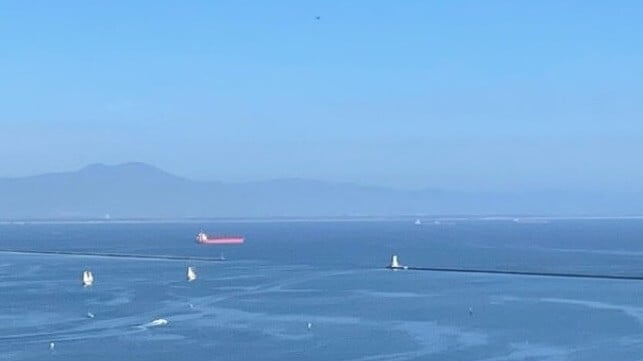Containership Backup is Declared Over in Southern California

The Marine Exchange of Southern California which oversees the movement of vessels into and out of the ports of Los Angeles and Long Beach officially declared that the backup of containerships has ended. Today, November 22, they are reporting for the first time that no containerships are waiting in the anchorage or being required to loiter offshore waiting for berths.
“After 25 months, and with concurrence of the Ports of Los Angeles and Long Beach, the Pacific Maritime Association (PMA), and the Pacific Merchant Shipping Association (PMSA), the containership backup for the ports of Los Angeles and Long Beach has ended,” announced Captain Kip Louttit, Executive Director of Marine Exchange of Southern California. He noted that they will be ending their special reports but will continue to assign Calculated Times of Arrival (CTAs) that determine the order of queuing for labor at the ports.
Just over a year ago, the organizations working with the ports agreed to the new queuing system which Louttit notes didn't solve the backup but moved the backed-up container ships 50-150 miles offshore, outside the safety and air quality area. “The new system worked superbly for the past 53 weeks to guide the labor allocation process, improve safety, and improve air quality,” says Louttit.
When the queuing system was established, there were 86 containerships anchored or loitering/drifting in the area near the twin ports. The backups started to build in October 2020, reaching more than 40 vessels by early 2021. At the end of January 2021, they reported that for the first time in 17 years the anchorage was full and that they had for the first time since 2004 placed containerships in drift positions after having filled both the main and an overflow anchorage zones.
It was just the beginning, with the backlog steadily rising through the remainder of 2021. The Marine Exchange highlights that the backlog peaked on January 9, 2022, when the backlog reached 109 vessels. Most of 2022 has seen a decline in the numbers as vessels first agreed to slow steam across the Pacific to time their arrival to available berth space and then more recently as volumes declined on the Pacific and carriers increasingly returned to blanking sailings for their schedules.
For the past few weeks, the Marine Exchange was reporting that the backlog for containerships had fallen to single digits. As recently as November 17, they reported that there were three containerships slow steaming into the ports and one at anchor awaiting refueling.
The declared end of the backlog and the reporting is due to the fact the Marine Exchange says that there is ample labor to discharge and load the cargo for containerships. They also note that the ocean carriers are working with their terminals, to optimize their vessel operations.
As further evidence, they report that while there are nine containerships due to arrive at the ports over the next three days, all of them are expected to proceed directly to their berths. Going forward they will continue to maintain the anchorages at 40 to 60 percent of capacity noting that ships have become so much larger than when the anchorages were mapped out. While the goal remains to have all containerships proceed to their berth, the Marine Exchange and the other organizations recognize that there are instances when a vessel will need to anchor.
Coinciding with the end of the backlog, both of the ports reported that volumes have declined sharply in the past two months as consumers shift their spending patterns and retailers slowed their imports. In addition, carriers rescheduled and rerouted vessels working with shippers to send more containers to East and Gulf Coast ports. The Port of Los Angeles, for example, noted in October that its terminals were operating at approximately 70 percent of capacity. The Port of New York and New Jersey has become the busiest U.S. container port while both of the southern California ports have said their goal is to build their container volumes in the future.
